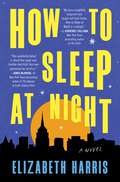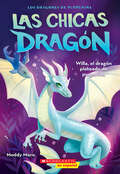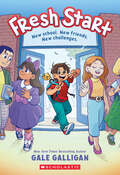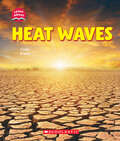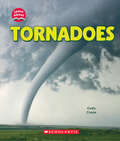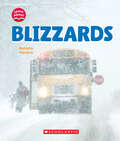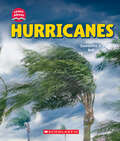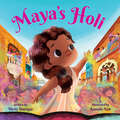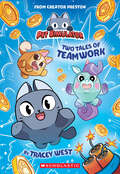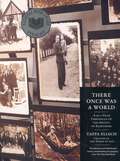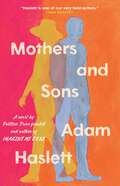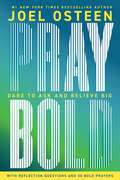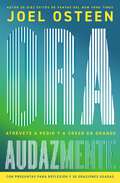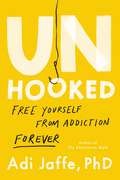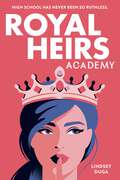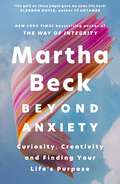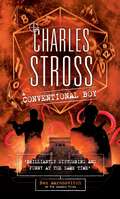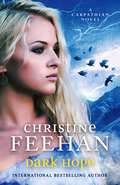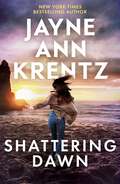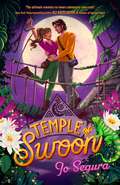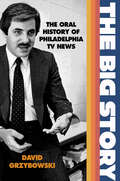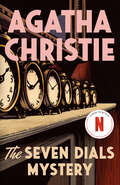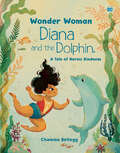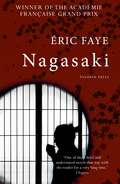- Table View
- List View
How to Sleep at Night: A Novel
by Elizabeth Harris"By turns insightful, poignant and laugh-out-loud funny, How To Sleep at Night is a delight."— J. Courtney Sullivan, New York Times Bestselling author of Friends and Strangers“This wonderful debut is about the rough and tumble road that true love represents for all of us." --James McBride, #1 New York Times bestselling author of The Heaven and Earth Grocery Store“This debut sparkles with wit and insight. I found myself laughing and gasping in equal measure. A true testament to the complexities of modern relationships—this book is a must-read for anyone who's ever wondered how to bridge the gap between who we are and who we aspire to be." —Dolly AldertonA witty and whip-smart novel about love, marriage, and family ties stretched thin by ambition.Meet Ethan and Gabe. A devoted couple for years, they have successful careers, an adorable daughter, and a house in the New Jersey suburbs. Sure, they may have drifted to different ends of the political spectrum, but their marriage still has its spark. Then one night Ethan makes an announcement: he wants to run for Congress as a Republican—but only if he has progressive Gabe’s blessing. For weeks a slightly queasy Gabe struggles between supporting his husband and maintaining his own lefty ideals. He can feel himself slowly pulled under the tide of Ethan’s ambitions, even as he becomes widely known as a conservative spouse. In a nearby town, suburban mom Nicole wonders what happened to her younger self—living in New York City, freely dating men and women, and on a path to a career in the art world. Nicole feels like an accessory in her husband’s life and like she’s given up on the goals she had for herself. Then an old flame re-enters her life unexpectedly. That woman is Ethan’s sister Kate.A political reporter at a major newspaper, Kate has reached the top of her profession. But the adrenaline rush of chasing a story has lost its thrill. When Nicole—the woman who broke her heart—slides into her DMs just as her brother starts his controversial congressional run, Kate’s life is thrown into a tailspin that threatens to derail the success she’s worked so hard to achieve.“A sharply funny exploration of marriage and ambition, How to Sleep at Night has the feel of whispered secrets exchanged over cocktails with your smartest friend.”–Jenny Jackson, New York Times bestselling author of Pineapple Street“This wonderful debut is about the rough and tumble road that true love represents for all of us." — James McBride, #1 New York Times bestselling author of The Heaven and Earth Grocery Store
Las chicas dragón #2: Willa, el dragón plateado de purpurina (Dragon Girls)
by Maddy MaraLas chicas dragón es una nueva serie coleccionable que celebra el fuego interior de las chicas comunes.Los problemáticos trasgos sombríos están nuevamente tras la magia de la reina Árbol, que solo puede ser protegida con una poción especial. Las chicas dragón deben trabajar juntas para reunir todos los ingredientes. Willa lidera la búsqueda, pero tiene miedo de lo que podría pasar si no lo logran. ¿Podrá aceptar su fuego interior a tiempo o el bosque estará perdido para siempre?Dragon Girls is a super collectible new series that celebrates the inner fire of everyday girlsThe troublesome Shadow Sprites are after the Tree Queen's magic again, and it can only be saved by a special potion. The Dragon Girls must work together to gather all of the ingredients. Willa is leading their quest, but she's scared of what might happen if they don't succeed. Can she embrace her inner fire in time-or will the forest be lost forever?
Fresh Start: A Graphic Novel
by Gale GalliganFrom New York Times bestselling author Gale Galligan comes a funny and vibrant semi-autobiographical middle-grade graphic novel about friendship and belonging.Ollie Herisson's dad is a diplomat, which means her family moves around a lot. She has already lived in Singapore, Korea, France, and the United States. When Ollie starts at a new school, she doesn't worry about making a good impression because she knows that when her family inevitably moves again, she'll get a fresh start somewhere else. A complete reset. It doesn't matter if her classmates think she's weird for pretending that she lives in the world of an imagined anime, or if she makes an enemy out of the most popular girl in her class, or if she does something hugely embarrassing! And it definitely doesn't matter that all her mom wants is for Ollie to be more of a proper Thai daughter.But after moving from Germany to Virginia and having a mortifying first day at her new school, Ollie is shocked to learn that her parents are going to buy a house so that Ollie and her sister, Cat, can finish grade school in one place. Can Ollie figure out how to both be herself and make real friends when she can't run away from her life?
Heat Waves (Learn About)
by Cody CraneLearn about wild weather events, including how to prepare for them, with this new series of fascinating books! A heat wave is a period of unusually high temperatures that lasts for more than two days. Experts say climate change is making heat waves more frequent and more intense.Discover why heat waves happen, how they are measured, and how we can prepare for them in Heat Waves, a perfect first introduction to the topic for young readers.About This Series:In the era of climate change, wild weather events such as hurricanes, tornadoes, heat waves, and blizzards are becoming more frequent and more destructive. Now more than ever, education around these topics is essential. Using age-appropriate language and easy-to-understand science, the books in this series will offer a first exploration of different wild weather events that can be unleashed on Earth: why they happen, how they are measured, and how we can prepare for them. Illustrated with arresting full-color photography and sprinkled with fascinating facts, these books will follow pioneering climate change curricula for early elementary grades across the United States.
Tornadoes (Learn About)
by Cody CraneLearn about wild weather events, including how to prepare for them, with this new series of fascinating books! Tornadoes are violently swirling columns of air that touch down on land. Experts are still researching how climate change affects tornadoes-including where and when they will strike. Discover why tornadoes happen, how they are measured, and how we can prepare for them in Tornadoes, a perfect first introduction to the topic for young readers.About This Series:In the era of climate change, wild weather events such as hurricanes, tornadoes, heat waves, and blizzards are becoming more frequent and more destructive. Now more than ever, education around these topics is essential. Using age-appropriate language and easy-to-understand science, the books in this series will offer a first exploration of different wild weather events that can be unleashed on Earth: why they happen, how they are measured, and how we can prepare for them. Illustrated with arresting full-color photography and sprinkled with fascinating facts, these books will follow pioneering climate change curricula for early elementary grades across the United States.
Blizzards (Learn About)
by Natasha VizcarraLearn about wild weather events, including how to prepare for them, with this new series of fascinating books! A blizzard is a storm with high winds that blow snow around. It lasts for more than three hours. Experts say climate change is making these storms even fiercer. Discover why blizzards happen, how they are measured, and how we can prepare for them in Blizzards, a perfect first introduction to the topic for young readers.About This Series:In the era of climate change, wild weather events such as hurricanes, tornadoes, heat waves, and blizzards are becoming more frequent and more destructive. Now more than ever, education around these topics is essential. Using age-appropriate language and easy-to-understand science, the books in this series will offer a first exploration of different wild weather events that can be unleashed on Earth: why they happen, how they are measured, and how we can prepare for them. Illustrated with arresting full-color photography and sprinkled with fascinating facts, these books will follow pioneering climate change curricula for early elementary grades across the United States.
Hurricanes (Learn About)
by Samantha S. BellLearn about wild weather events, including how to prepare for them, with this new series of fascinating books! Hurricanes are violent storms with high winds and a lot of rain. Experts say climate change is making them even more intense. Discover why hurricanes happen, how they are measured, and how we can prepare for them in Hurricanes, a perfect first introduction to the topic for young readers.About This Series:In the era of climate change, wild weather events such as hurricanes, tornadoes, heat waves, and blizzards are becoming more frequent and more destructive. Now more than ever, education around these topics is essential. Using age-appropriate language and easy-to-understand science, the books in this series will offer a first exploration of different wild weather events that can be unleashed on Earth: why they happen, how they are measured, and how we can prepare for them. Illustrated with arresting full-color photography and sprinkled with fascinating facts, these books will follow pioneering climate change curricula for early elementary grades across the United States.
Maya's Holi
by Thrity UmrigarCelebrate Holi, the festival of colors, sharing, and love with Maya as she visits her grandparents in India for the spring jubilee.Maya loves visiting her grandparents in India, and this year is extra special because she is celebrating Holi with them. Maya and her family start the magical day by eating a special breakfast, including rasgulla dumplings and glasses of mango lassi. They put on colorful clothing and join the celebration out in the streets. The air fills with joyful songs and clouds of blue, red, and purple powder. On this special vacation, Maya can feel the magic of Holi.When Maya returns to America, she carries the exhilarating energy of Holi with her. The spirit of the holiday -- hope and forgiveness and love -- keeps her warm.Marking the end of winter and the beginning of spring, Holi takes place on March 14, 2025. It offers people the opportunity to begin anew -- to have a fresh start. Thrity Umrigar's heartfelt text and Kamala Nair's richly colorful, exuberant illustrations fill the pages with happiness and joy. Informative back matter will teach readers about the history and traditions of Holi.
Two Tales of Teamwork (Pet Simulator Illustrated Novel #1)
by Tracey WestJoin an adventure with all of your favorite pets in two, fun-filled original Pet Simulator stories!Can't get enough Pet Simulator? Explore the delightful world of collecting coins, snatching up rare eggs, and raising the cutest pets around in this totally original chapter book with TWO stories! Join Whiskers the Cat, Ruffles the Dog, and Penny the Unicorn as they try to solve the Riddle of Rainbow Ravine and win the Great Pet Race in this hilarious chapter book filled with tons of laughs, action, and exciting artwork. This book from bestselling author Tracey West is sure to delight fans of Pet Simulator.
There Once Was a World: A 900-Year Chronicle of the Shtetl of Eishyshok
by Yaffa EliachFor 900 years the Polish shtetl was a home to generations of Jewish families. In 1944 almost every Jew was murdered and with them died a way of life that had survived for centuries. Yaffa Eliach has written a landmark history of the shtetl.
The NEAT Method Organizing Recipe Book: 70 Simple Projects to Take Your Home from Chaos to Composed
by Ashley Murphy Marissa Hagmeyer"A master class in functional style" (Billy Cotton), by the founders of NEAT Method In this one-of-a-kind organizing book, the projects are as simple as recipes, with &“ingredient&” lists and clear step-by-step directions. There are smart, stylish solutions for every room in the house, including quick wins that can be accomplished in just twenty minutes as well as larger overhauls that may take an hour or more, including: A &“drop zone&” for dirty shoes and sports gear at the garage door Compartmentalized drawers for everything from kitchen utensils to makeup to socks A color-coded bedroom closet A playroom kids will actually keep tidy And much more! The end result is transformative: By implementing solutions that emphasize beauty as much as function, you&’ll create a home that&’s well arranged, a true place of calm and simplicity.
Mothers and Sons: A Novel
by Adam HaslettA mother and son, estranged for years, must grapple with the shared secret that drove their lives apart in this enthralling story about family, forgiveness, and how a fleeting act of violence can change a life forever, by "one of the country's most talented writers" (Wall Street Journal) At forty, Peter, an asylum lawyer in New York City, is overworked and isolated. He spends his days immersed in the struggles of immigrants only to return to an empty apartment and occasional hook-ups with a man who wants more than Peter can give. But when the asylum case of a young gay man pierces Peter's numbness, the event that he has avoided for twenty years returns to haunt him. Ann, his mother, who runs a women's retreat center she founded after leaving his father, is hurt by the estrangement from Peter but cherishes the world she has built. She long ago put behind her the decision that divided her from her son. But as Peter&’s case plunges him further into the fraught memory of his first love and the night of violence that changed his life, he and his mother must confront the secret that tore them apart. With unsurpassed emotional depth, Mothers and Sons reveals all that is lost by looking away from the past and the love that might be restored by facing it. In his spellbinding new novel, Adam Haslett demonstrates yet again his mastery of &“a rich assortment of literary gifts&” (New York Times).
Pray Bold: Dare to Ask and Believe Big
by Joel OsteenHave you ever wondered how to experience great things from God in your life? It&’s time to bold size your prayers and watch what God can do. New York Times bestselling author Joel Osteen wants you to know that God is listening and waiting for you take the limits off and ask Him for your dreams, for the big things in your heart, for your deepest hopes, for what looks impossible. Ask Him for explosive blessings. Ask Him to propel you into your purpose. Ask Him to restore a relationship that looks over and done. Ask Him in spite of what the circumstances look like. How many miracles are we missing out on because we&’re not praying bold? Bold prayers get God&’s attention. Bold prayers get bold results. Bold prayers cause angels to go to work. Bold prayers open doors you could never open. Bold prayers turn impossible situations around. When you pray boldly, you&’re releasing your faith, and you&’ll see God do the uncommon. Bold things happen! Pray Bold will challenge you to think bigger, to stretch your faith, to receive what you&’re believing for when you pray, and to pray prayers that move the hands of God. You&’ll learn to pray with confidence, you&’ll dare to pray bold, and that&’s when you&’ll see the all-powerful Creator of the universe go to work. You&’ll see God do the extraordinary and show out in ways greater than you ever imagined. Pray with boldness and God will set your miracle in motion.
Ora audazmente (Pray Bold): Atrévete a pedir y a creer en grande
by Joel Osteen¿Alguna vez te has preguntado cómo experimentar las grandísimas cosas de Dios en tu vida? Es hora de que ores con valentía y veas lo que Dios puede hacer. El autor más vendido del New York Times, Joel Osteen, quiere que sepas que Dios te escucha. Y Él espera que quites los límites y le pidas por tus sueños: aquellas cosas grandes que tu corazón anhela, tus esperanzas más profundas, lo que parece imposible. Pídele bendiciones de impacto. Pídele que te impulse hacia tu propósito. Pídele que restaure alguna relación que parece terminada. Pídele a pesar de cómo se vean las circunstancias a tu alrededor. ¿Cuántos milagros nos estamos perdiendo por no orar audazmente? Las oraciones audaces llaman la atención de Dios. Las oraciones intrépidas obtienen resultados intrépidos. Las oraciones audaces logran que los ángeles trabajen a tu favor. Las oraciones osadas abren puertas que tú nunca podrías abrir. Las oraciones valientes transforman situaciones que son imposibles. Cuando oras con audacia, liberas tu fe y ves a Dios hacer lo extraordinario. ¡Cosas intrépidas suceden! Ora audazmente te desafiará a soñar en grande, a expandir tu fe, a recibir lo que estás creyendo cuando oras, y a declarar oraciones que mueven la mano de Dios. Con la ayuda de preguntas que se incluyen para una mayor reflexión y treinta oraciones audaces, aprenderás a orar con confianza, te atreverás a orar con osadía y entonces verás al Todopoderoso y Creador del universo en acción. Experimentarás a Dios hacer lo extraordinario y manifestarse de maneras más grandiosas de las que jamás imaginaste. Ora audazmente y Dios pondrá en marcha tu milagro.Have you ever wondered how to experience great things from God in your life? It&’s time to bold size your prayers and watch what God can do. New York Times bestselling author Joel Osteen wants you to know that God is listening and waiting for you take the limits off and ask Him for your dreams, for the big things in your heart, for your deepest hopes, for what looks impossible. Ask Him for explosive blessings. Ask Him to propel you into your purpose. Ask Him to restore a relationship that looks over and done. Ask Him in spite of what the circumstances look like. How many miracles are we missing out on because we&’re not praying bold? Bold prayers get God&’s attention. Bold prayers get bold results. Bold prayers cause angels to go to work. Bold prayers open doors you could never open. Bold prayers turn impossible situations around. When you pray boldly, you&’re releasing your faith, and you&’ll see God do the uncommon. Bold things happen! Pray Bold will challenge you to think bigger, to stretch your faith, to receive what you&’re believing for when you pray, and to pray prayers that move the hands of God. You&’ll learn to pray with confidence, you&’ll dare to pray bold, and that&’s when you&’ll see the all-powerful Creator of the universe go to work. You&’ll see God do the extraordinary and show out in ways greater than you ever imagined. Pray with boldness and God will set your miracle in motion.
Unhooked: Free Yourself from Addiction Forever
by Adi JaffeLearn to identify the "hooks" that trigger your addictive behavior and replace compulsive habits with constructive ones using this helpful guide from a mental health expert. As a young man, Dr. Adi Jaffe&’s own battle with addiction nearly landed him a decades-long prison sentence. Now, his revelatory addiction treatment protocol has helped thousands to free themselves from the addictive habits that cause negative consequences. Dr. Jaffe&’s shame-free, step-by-step program helps you address what's driving your addiction by: ·Identifying the &“hooks&” that drive your behavior ·Building awareness of when these hooks are activated ·Unpacking your go-to habitual responses ·Creating new, healthier patterns and ways of reactingThe Unhooked Method destigmatizes addiction and uses habit change knowledge and tools to help you to unhook for an addiction-free life.
Royal Heirs Academy
by Lindsey DugaIn this story filled with &“romantic tension, royal drama, and family secrets&” (Kristy Boyce), four teens living in a glamorous boarding school must compete in order to inherit a European kingdom. Perfect for fans of Elite and Maxton Hall—The World Between Us. For fifty years, King Leander Eldana has ruled Ashland without naming an heir to the crown. After sending away his grandchildren to be raised out of the public eye, it&’s finally time to secure his nation&’s future by appointing one definitive heir. The best way to appraise his successor? In the halls of Almus Terra Academy, a boarding school infamous for breeding the world&’s next generation of leaders—and liars. Titus Eldana has always known he&’d inherit Ashland&’s future. Now he must prove he has what it takes. Alaric Eldana was not raised with a silver spoon. His secondhand clothes might not be fit for a king, but he knows how to rule: with his fist. Emmeline Eldana only wants to please her neglectful parents. If that means securing the crown, she won&’t hesitate to destroy anyone in her way. Sadie Aurelia has no idea why she&’s been given a chance to bring new blood to the throne. With nothing left to lose back home, she&’s ready to take it. Filled with competition, secret alliances, enemies-to-lovers romance, and cunning revenge, Royal Heirs Academy is a breathless, entertaining read set in modern-day. This gossip-filled school for the global elite is inspired by UWC of the Atlantic, which Vanity Fair has described as "Hippie Hogwarts." For fans of the breakout television hits Elite and Maxton Hall—The World Between Us.
Beyond Anxiety: Curiosity, Creativity and Finding Your Life's Purpose
by Martha BeckFrom bestselling author Martha Beck, a new path to overcoming anxiety by awakening the creativity within.We live in an epidemic of anxiety. Most of us assume that the key to overcoming it is to think our way out. And for a while it works. But there is always something that sends us back into the anxious spiral we've been trying to climb out of.In Beyond Anxiety, Dr Martha Beck explains why anxiety is skyrocketing around you, and likely within you. She also tells you how to not only reduce your anxiety but use it to propel you into a life filled with peace, meaning, and joy.Using a combination of the latest neuroscience as well as her background in sociology and coaching, Beck explains how our brains tend to get stuck in an 'anxiety spiral,' a feedback system that can increase anxiety indefinitely. To climb out, we must engage different parts of our nervous system - the parts involved in creativity. Beck provides instructions for engaging the 'creativity spiral,' in a process that not only shuts down anxiety but leads to innovative problem solving, a sense of meaning and purpose, and joyful, intimate connection with others - and with the world.The opposite of anxiety, it turns out, is a wonderful new way of life - one that can calm and inspire us as individuals and help us become a source of healing for everything around us.
A Conventional Boy
by Charles StrossIn A Conventional Boy, the fate of the world will depend on a roll of the dice... twenty-sided dice, that is. In 1984, Derek Reilly was just another teenage nerd growing up in middle England. But his love of D&D caused him to fall afoul of the Laundry, a government agency tasked with suppressing supernatural threats. It turns out that sometimes ninth level wizard spells drawn on the back of your maths textbook can look suspiciously like actual magic...Decades later, Derek is a long-term inmate at Camp Sunshine, a centre for deprogramming captured cultists. But Derek finally has reason to escape, and an escape plan to out into action: he wants to attend his first gaming convention. While Derek's D&D games were fictional, a game at the con really is a dread ritual designed to summon a great evil into our world, and it's up to Derek and his players to stop them.The fate of the world may depend on the contents of Derek's dice bag.The Laundry Files series follows an agency of British spies who deal with supernatural threats; they also have to deal with chronic underfunding, government ministers, rival agencies and worst of all, each other. Think Slow Horses crossed with the monsters from Stranger Things, this series is funny, nerdy, and a cult classic.***Publishing just ahead of the final Laundry Files novel (The Regicide Report, summer 2025), this new collection includes the never before published Laundry Files novel A Conventional Boy - inspired by the 1980s Satanic Panic - and two other short stories in this joyous celebration of all things Laundry Files.***In this collection:*A CONVENTIONAL BOY (53.3k words)*DOWN ON THE FARM (12.7k words)*OVERTIME (8.7k words)also includes exclusive afterword from Charles Stross
Dark Hope (Dark Carpathian #43)
by Christine FeehanThe next addictive novel in the worldwide bestselling Dark Carpathian series . . .Silke Vriese Reinders knows a war is coming. The demon slayer has seen it over and over again in the cards-and the battle won't just be for the survival of her remote village, but for all mankind. Silke knows the only way to win will be with the help of the Carpathians. A fact that fills her with trepidation, as she is fated to be the lifemate to one of the ancient supernatural warriors-bound to a complete stranger and responsible for his soul.One of the oldest, most dangerous Carpathians, Benedek Kovak is more beast than man. Locked away for centuries, the only thing that has stopped him from becoming one of the monsters he's sworn to defeat is the thought of his lifemate. When Benedek senses the impending danger, he sets out to find her before it's too late. But their enemy has laid a trap that pushes him closer to turning than ever before.For so long Benedek has felt nothing. Now, some dark art is compelling him to indulge in cravings he thought long buried. He has no hope that anyone can restore what's left of his tainted soul, but Silke is nothing like he imagined. Perhaps she's strong enough to fight back the darkness. Perhaps together they can defeat an adversary hell bent on destroying them all. . . .
Shattering Dawn (The Lost Night Files)
by Jayne Ann Krentz'Sparkles with wit and clever plotting' Publishers Weekly'Sexy . . . clever, fun' Kirkus ReviewsAn unsettling investigation teaches two deeply suspicious people how to trust in the next thrilling novel of the Lost Night Files trilogy by New York Times bestselling author Jayne Ann Krentz.Amelia Rivers, a member of the Lost Night Files podcast team, hires private investigator Gideon Sweetwater to catch the stalker who has been watching her. Amelia suspects the stalker may be connected to the shadowy organization responsible for the night that she and her two friends lost to amnesia - a night that upended their lives and left them with paranormal talents.Gideon suspects that Amelia is either paranoid or an outright con artist, but he can't resist the chemistry between them. He takes the case despite his skepticism. For her part, Amelia has second thoughts about the wisdom of employing the mysterious Mr. Sweetwater. She is wary of the powerful attraction between them, and deeply uneasy about the nightmarish paintings on the walls of his home. She senses they were inspired by his own dreamscapes.Amelia knows she doesn't have time to find another investigator, and Gideon is forced to reckon with the truth when he disrupts what was intended to be Amelia's kidnapping. Now the pair is on the run, with no choice but to return to the haunting ruins of the old hotel where Amelia's lost night occurred. They are desperate to stop a killer and the people who are conducting illegal experiments with a dangerous drug that is designed to enhance psychic abilities. If they are to survive, they will have to trust each other and the passion that bonds them.Find out why readers are RAVING about Jayne Ann Krentz: 'Krentz expertly entwines high-stakes suspense, a paranormal-spiked plot, and a generous dollop of sexy romance with delightfully dry wit as she launches a thrilling and chilling new series' Booklist (starred review)'A smart, creative series start from a romance master who always entertains' Kirkus Reviews (starred review)
Temple of Swoon: the perfect enemies-to-lovers adventure romance
by Jo Segura'Everything I wanted: riotous fun, heart-clenching romance, and pitch-perfect characters!' CHRISTINA LAURENA laugh-out-loud romcom with a twist. Perfect for fans of Ali Hazelwood, The Lost City and a good old fashioned enemies-to-lovers.Her mission: find the Lost City of the Moon in the Amazon rainforest. His mission: protect the holy temple . . . and his heart.While her mentor may be the world's most badass archaeologist, the only thing bad about Dr Miriam Jacobs are her corny jokes. But when Miri is charged with leading an unmapped expedition through the Amazon for the fabled Lost City of the Moon, she finally has her chance to prove to her colleagues that she's capable - and hopefully prove it to herself, too. Journalist Rafael Monfils has joined the archaeological team to chronicle their search for the lost city. Or at least, that's what they think he's doing. Rafa's real goal? Make sure the team does not reach the Cidade da Lua, stopping the desecration of the holy city and protecting his mother's legacy. All he needs to do is keep them on the wrong path. If only the endearingly quirky Dr Jacobs wasn't so damn tenacious - each of Rafa's tricks and purposeful wrong turns only seem to fuel her determination. Even worse, he's charmed by her goofy attempts to channel Lara Croft as they traverse the dangerous Brazilian rainforest. But they're not the only crew hunting for the lost city, and soon the untamed jungle - and their untamed hearts - might be the least of their worries . . .Why readers love Jo Segura: 'The ultimate enemies-to-lovers adventure romcom!' ALI HAZELWOOD'Romancing the Stone meets Indiana Jones in this thrilling adventure romance' Entertainment Weekly'A true adventure romcom - filled with snappy banter, heart-pounding twists and turns' ALICIA THOMPSON'Snappy banter and sizzling tension in an enemies-to-lovers romance' ADRIANA HERRERA'Everything I'm looking for in an adventure romance. It's full of humour and heart-pounding action, and is steamier than the Amazon itself' JENNA LEVINE
The Big Story: The Oral History of Philadelphia TV News
by David Grzybowski“He was much like the Walter Cronkite of Philadelphia.”—Ed Rendell, former Philadelphia Mayor and Pennsylvania Governor, about Jim Gardner, the trusted voice of WPVI’s Action News for 47 years “We were the only station that stayed on the air continuously. We even pre-empted the CBS evening news.”—Larry Kane, anchor at WCAU, about covering the MOVE bombing “The highs of working during the pandemic were keeping people informed of this deadly virus and what they had to do to take care of themselves and each other.”—Ukee Washington, KYW anchor, on the pandemic The Big Story is David Grzybowski’s engrossing oral history of Philadelphia TV news from the perspective of reporters, photographers, producers, and news directors. Covering all the big stories from the late 1970s through the present, this fast-paced running commentary reflects on the uncertainty of the Three Mile Island disaster, the thrill of the Live Aid concert, the “Storm of the Century” (that wasn’t), and the championship victories of the Phillies and the Eagles, among other notable events, local, national, and global. The Big Story features more than 200 interviews, including anecdotes from seasoned Philadelphia anchors Jim Gardner, Larry Kane, Lisa Thomas-Laury, Mike Jerrick, Vai Sikahema, Tamala Edwards, Pat Ciarrocchi, and Cecily Tynan, among others, about their experience on and off the job. Decision makers reflect on how to cover hot news stories such as Pennsylvania State Treasure R. Budd Dwyer’s on-air suicide. (“It was a big bloody horrifying mess,” according to Chris Wagner, WPVI anchor.) Grzybowski highlights the Mummers, the launch of Good Day Philadelphia, off-the-air scandals, and how the Action News style secured a loyal following with Philadelphians while the Eyewitness News format competed hard to gain ratings. But the Big Story is how The Big Story provides compelling stories about Philadelphia’s news breakers and newsmakers.
The Seven Dials Mystery: A Novel
by Agatha ChristieA clever murder mystery featuring recurring character Superintendent Battle that pokes light-hearted fun at the international spy thriller genre--soon to be a major Netflix seriesGerry Wade is famous for over-sleeping, but when a group of his fellow young guests at a country house weekend decide to play a prank on him by setting eight alarm clocks to go off in his room early one morning, they are rewarded with a nasty surprise. This time, poor Gerry is quite literally dead to the world. As the police descend upon Chimneys, the historic estate of Lord Caterham, the youthful friends—led by the bold and clever Lady Eileen &“Bundle&” Brent—take investigative matters into their own hands. As more victims turn up dead and clues seem to point to a wider plot, Bundle and her pals risk their lives to find the murderer before he kills again.
Diana and the Dolphin (DC Wonder Woman)
by Chamisa KelloggWitness the transformative journey of young Diana, destined to become the iconic Wonder Woman, as she embraces her incredible powers on Paradise Island, in this beautifully illustrated and inspiring picture book that emphasizes the power of kindness and compassion in shaping a true hero.Wonder Woman was once a young girl—but an extraordinary one with great strength, great speed, and amazing abilities. But as she grows up on Paradise Island, she learns that sometimes the greatest strength is being kind, that sometimes slowing down to help friend is more important that winning, and that compassion can make the world a better place more than any act of heroism. Young readers will love this jacketed picture book that presents a unique vision of what it takes to become a hero.
Nagasaki
by Eric FayeIn a house on a suburban street in Nagasaki, meteorologist Shimura Kobo lives quietly on his own. Or so he believes.Food begins to go missing. Perturbed by this threat to his orderly life, Shimura sets up a webcam to monitor his home.But though eager to identify his intruder, is Shimura really prepared for what the camera will reveal?Based on real-life events, this prize-winning novel is a moving tale of alienation in the modern world.
